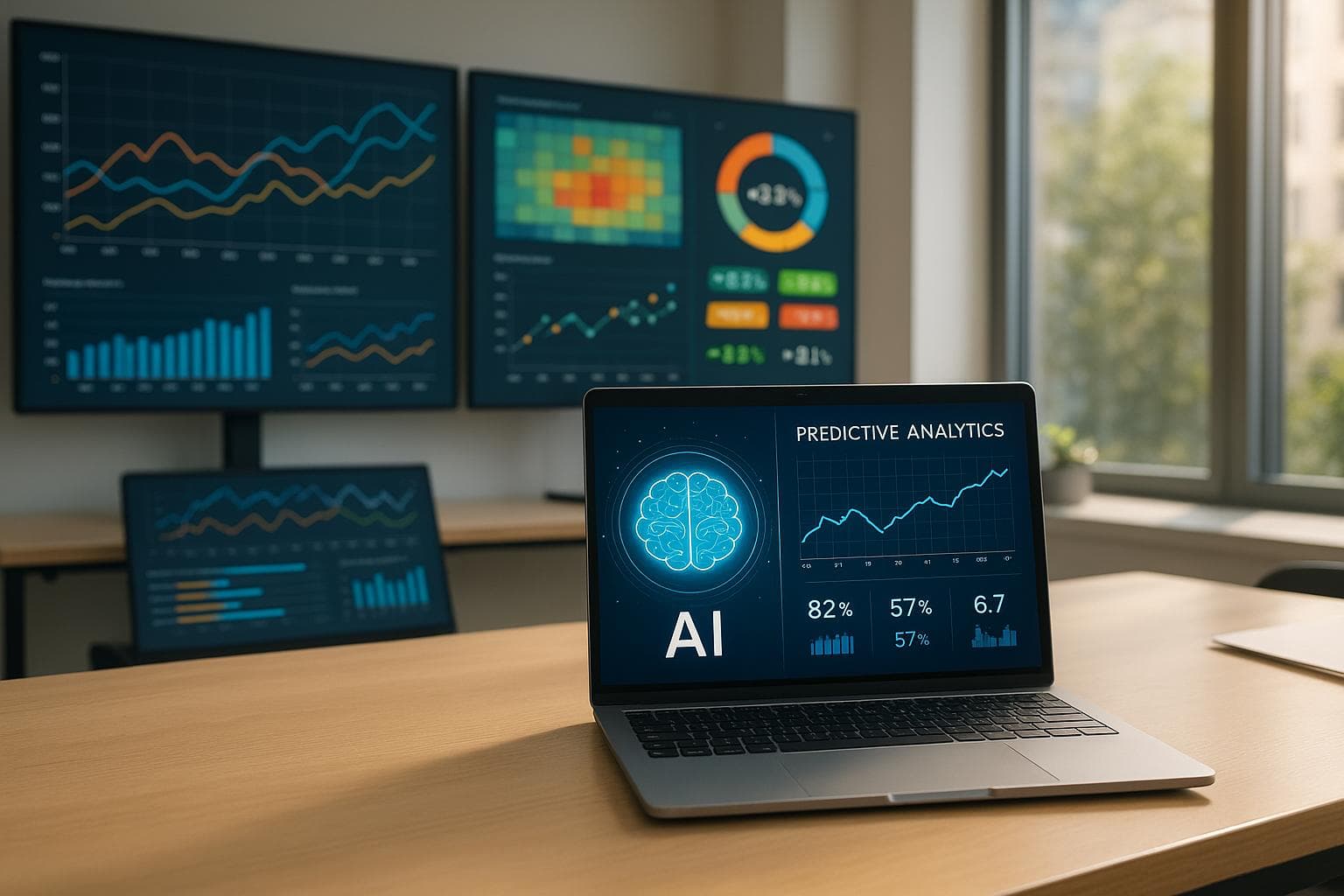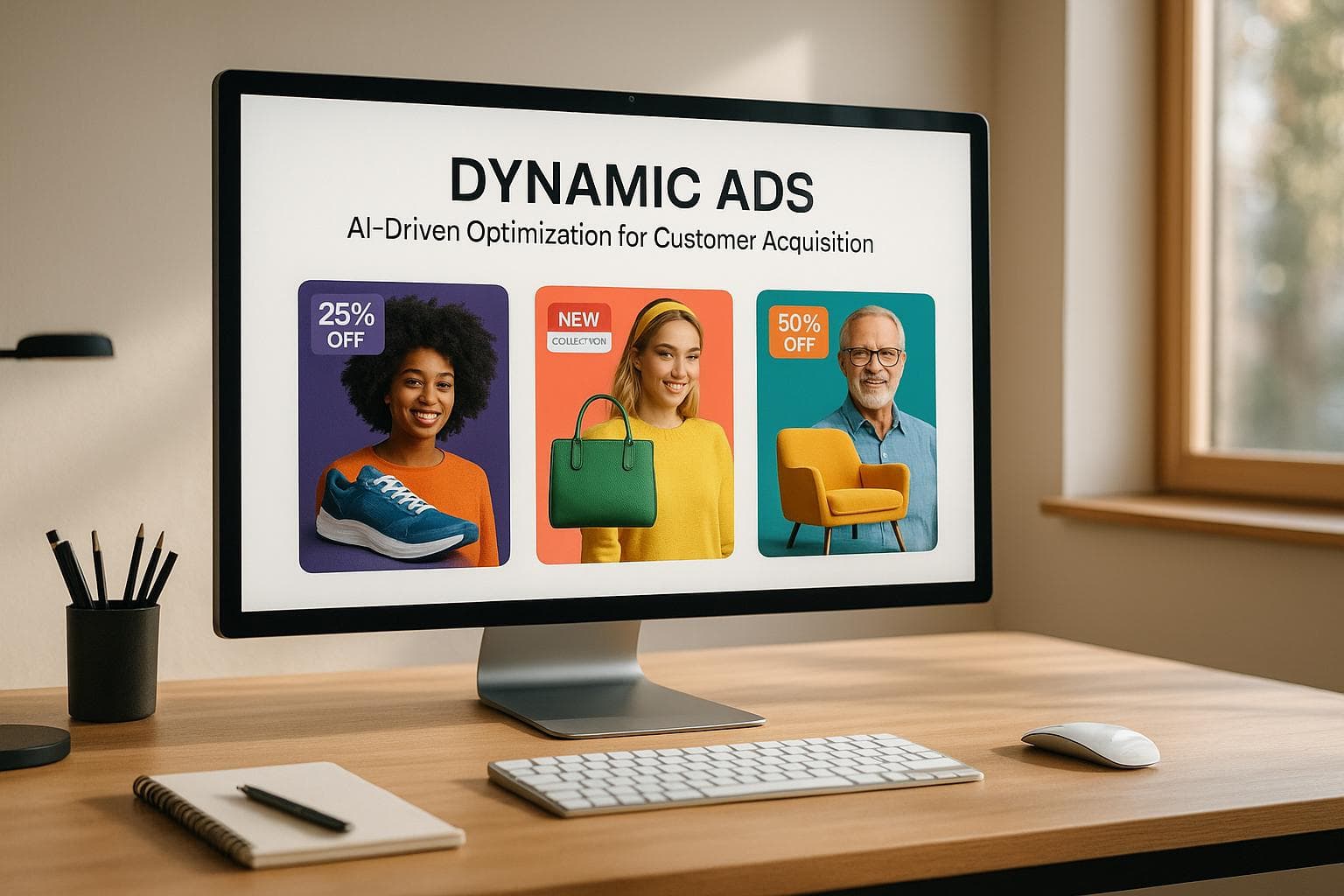How AI Improves Ad Copy Localization
AI revolutionizes ad copy localization by enhancing speed, cost efficiency, and accuracy, leading to better engagement and higher ROI.
AI is transforming ad copy localization by making it faster, more precise, and cost-effective. Traditional methods relied heavily on human translators, often leading to delays and higher costs. AI-powered tools now streamline the process, delivering localized content in hours instead of weeks while reducing costs by up to 90%. Here's what you need to know:
- Speed: AI tools cut localization time by 80%, enabling quicker campaign launches.
- Cost Savings: Automation reduces expenses by up to 60–90%.
- Accuracy: AI reduces translation errors by 50%, ensuring consistent brand messaging.
- Relevance: AI adapts content to local preferences, improving engagement and conversion rates.
- Business Impact: Companies using AI report up to 30% higher ROI and significant boosts in conversion rates.
With AI, businesses can scale localization efforts without sacrificing quality, making global campaigns more efficient and effective.
Best AI Translator For Marketing & Landing Page Copy? (ChatGPT-4 vs DeepL)
Main Benefits of AI-Powered Ad Copy Localization
AI-powered localization is reshaping international marketing by making it faster, more cost-effective, and better suited to local audiences.
Faster Campaign Launches
AI tools can localize content in a matter of minutes, allowing businesses to align localization efforts with campaign production timelines [2]. This speed is a game-changer, helping companies seize seasonal opportunities, address competitive pressures, and hit the market at just the right moment [4].
A great example of this in action is Firsty, which integrated AI localization with its content management system. The company managed to localize around 1,500 pages into five languages in just a few hours [4]. With AI, translation times are slashed by up to 80%, turning what used to take hours into mere minutes [2][1].
This rapid turnaround doesn’t just save time - it also unlocks cost savings.
Lower Costs Through Automation
By automating repetitive tasks, AI dramatically reduces localization expenses. Companies that adopt AI localization platforms report cutting manual costs by as much as 60% [4]. In some cases, total translation costs drop by 60–90% [5]. These savings free up resources for more strategic and creative tasks, making teams more productive.
Take MakesYouLocal, for instance. Their e-commerce implementation reduced translation costs by an impressive 90%, all while improving quality metrics [4]. AI’s efficiency also means businesses can scale their localization efforts without needing to hire additional staff [2].
The financial perks don’t stop at translation. Faster market entry means businesses can start generating revenue sooner [4]. Plus, fewer errors in translations reduce the costs tied to fixing mistakes or clarifying miscommunications. With AI, companies can allocate their budgets more wisely, focusing on creative strategies and cultural nuances instead of routine translation work.
These efficiencies work hand-in-hand with AI’s ability to adapt content for local audiences.
Better Local Relevance
AI doesn’t just translate - it tailors content to fit local preferences and cultural nuances. Unlike basic translation tools, AI-powered platforms analyze context to predict the best way to adapt messaging while keeping the brand’s voice intact. This ensures that ad copy not only makes sense but also resonates with local audiences.
For example, e-commerce platforms like Feedcast use AI to optimize product titles, descriptions, and other details specifically for local markets. This tailored approach boosts engagement by aligning with local shopping habits and preferences, leading to better visibility and ad performance.
When content speaks the language of its audience - both literally and culturally - it connects on a deeper level, driving higher engagement and better results.
More Consistent Quality
AI’s speed and cost benefits come with another major advantage: consistency. AI tools apply brand guidelines uniformly across all markets, eliminating the inconsistencies that can creep in with manual translations. While human translators might vary in tone or style, AI ensures a steady and reliable brand voice everywhere.
AI tools also enhance quality assurance by reducing translation errors by up to 50% [2]. They flag inconsistencies, check for potential issues, and ensure that marketing terminology and product details are always accurate. This level of precision minimizes confusion for customers and maintains a professional standard.
Additionally, AI preserves technical accuracy, such as formatting and product specifications, across different platforms. The result? Localized content that feels authentic to each market while staying true to the brand’s identity. This consistency builds trust, strengthens brand recognition, and fosters long-term customer loyalty across global markets.
Research Results: How AI Improves Localization Performance
AI's ability to streamline processes and enhance quality is well-documented, but the numbers really drive home its impact on localization performance. Data reveals that AI-driven localization significantly boosts key performance metrics, offering clear advantages over traditional approaches.
Before and After Performance Data
When it comes to lead targeting, AI-powered methods consistently outshine traditional techniques. Businesses using AI report a 30% increase in conversion rates compared to those sticking with older methods [7]. And it’s not just about quantity - AI improves lead quality scores by up to 40% [7], ensuring businesses attract better prospects who are more likely to convert.
Response rates tell a similar story. AI-powered lead targeting achieves response rates of up to 25%, compared to just 10% with traditional methods [7]. This directly translates into stronger campaign performance and a better return on ad spend.
The financial payoff is undeniable. Companies incorporating AI into their marketing strategies see 20-30% higher ROI on campaigns compared to those relying on traditional methods [6]. On top of that, automation powered by AI cuts manual tasks by up to 40% [7], freeing up teams to concentrate on higher-level strategic work.
AI's influence isn't limited to text-based localization. For example, AI-personalized audio ads increased brand favorability by 22 percentage points [8], showing how AI can create more engaging and effective content across various media formats.
These performance gains are not just theoretical - they’re backed by real-world examples of success.
Business Success Examples
The numbers come to life when you look at how companies are using AI to transform their results. Take Procter & Gamble, for example. By implementing AI-powered ad agents to automate campaign setup, manage bidding, and optimize audience targeting in real time, they achieved a 20% boost in sales conversions and cut ad management time by 60%. This significantly improved their cost per acquisition (CPA) and overall campaign efficiency [8].
Another standout example comes from the fitness industry. A client struggling with underperforming paid ads and a low return on ad spend (ROAS) of 1.2 turned to AI for help. AI-driven insights revealed that video ads outperformed static images, prompting the creation of new video content and tailored ad copy. Along with automated budget adjustments to prioritize top-performing ads, their ROAS jumped to 3.5 in just 30 days [8].
Booking.com took personalization to the next level with advanced AI technology, using predictive analytics and data-driven segmentation to deliver customized content and offers. The results? A 65.16% increase in cart additions, a 73.72% rise in conversion rates, and a 16.15% boost in average transaction value [8]. This showcases how AI localization goes far beyond simple translation, enabling a deeply personalized user experience.
The broader adoption of AI in marketing reflects these success stories. Over 80% of companies are already using AI in their marketing efforts [7], and 75% believe AI will be essential to their marketing and sales strategies within the next two years [7]. The reason? Tangible results. For instance, campaigns targeting well-segmented audiences see a 200% increase in conversion rates [9].
In e-commerce, the stakes are even higher. Brands leveraging AI in e-commerce are 23 times more likely to acquire new customers and 19 times more likely to achieve above-average profitability [9]. AI localization enhances local relevance while improving campaign efficiency, delivering transformative results.
"The future of paid advertising lies not in reaching more people, but in reaching exactly the right people with exactly the right message at exactly the right time. AI makes this level of precision possible." – Eric Siu, CEO of Single Grain [8]
From conversion rates to ROI, the evidence is clear: AI-powered localization delivers measurable, game-changing improvements across the metrics that matter most to advertisers.
sbb-itb-0bd1697
Important AI Localization Features for E-commerce
AI localization offers measurable benefits when equipped with the right features. For e-commerce businesses, it’s not just about translation - it’s about creating experiences that feel local. With nearly 80% of consumers avoiding brands that don’t support their native language [2], choosing the right AI tools becomes essential for success. These features help e-commerce brands maximize their potential in localized markets.
Audience Targeting and Personalization
AI’s advanced targeting capabilities take local engagement to the next level. By analyzing customer data - like demographics, purchase history, browsing habits, device usage, and location - AI can define highly specific audience segments [13]. This level of precision allows brands to craft personalized messages that truly connect with their customers.
Personalized recommendations are a game changer. They can boost conversion rates by up to 8% and increase average order value (AOV) by 12% [14]. When AI predicts customer needs based on behavioral patterns, the results are even stronger. For instance, Amazon attributes 35% of its revenue to its AI-driven recommendation engine [15], highlighting the immense revenue potential of such tools.
Retargeting is another powerful feature. By analyzing user activity and browsing history, AI delivers tailored ads that nudge customers through the buying process [13]. A great example is Carrefour Taiwan, which used Appier’s AI retargeting solution to increase its website conversion rate by 20% by offering coupons based on users’ previous browsing behavior [13].
Dynamic content adaptation also plays a key role in enhancing the customer journey. Luxury retailer LUISAVIAROMA leveraged Dynamic Yield’s AI recommendation system to add personalized suggestions at checkout, resulting in a 15% increase in average revenue per user (ARPU) [13].
AI-Powered Product Feed Management
Managing product feeds across multiple platforms can be a logistical nightmare, but AI simplifies and automates this process while ensuring accuracy and consistency [10]. AI tools can generate optimized product titles, descriptions, and keywords, translate content into various languages, and fine-tune messaging for specific product categories.
The numbers speak for themselves: 59% of marketers report satisfaction with AI-driven keyword research [10]. Retailers have also seen a 2–3% gross margin uplift and up to a 10% increase in revenue through AI-powered dynamic pricing [11]. These gains are achieved by tailoring product descriptions and recommendations based on customer behavior, making the content more engaging and relevant [12]. AI also ensures that product titles and attributes are optimized for each platform [12].
"80% of surveyed users already have been more efficient or expect to be more efficient by using Product Studio." – Google [10]
A tool like Feedcast.ai showcases the full potential of AI-powered feed management by enriching product data, fixing feed errors, and creating personalized ad copy for various channels.
U.S. Market Requirements
The U.S. market brings its own set of localization challenges, making tailored AI solutions essential. For example, AI tools must handle U.S. currency (USD with proper comma separators), dates (MM/DD/YYYY), and imperial measurement units.
Cultural sensitivity is especially crucial in the U.S., where preferences and shopping behaviors can vary significantly across states and demographic groups. By localizing PPC ad copy and landing pages for different regions, one campaign saw a click-through rate jump from 1% to 8% and a conversion rate improvement from under 1% to 7% within six months [3].
AI tools equipped with style guides and glossaries ensure that brand voice remains consistent while adapting content to local requirements [2]. These tools not only speed up time to market by up to 80% [2] but also reduce localization costs by up to 60% [2]. Furthermore, AI-driven quality assurance tools can cut translation errors by 50% [2], meeting the high standards that U.S. consumers expect.
Tailoring content to meet these requirements can significantly enhance market performance.
Best Practices for AI Ad Copy Localization
Maximizing the potential of AI for ad copy localization requires a thoughtful approach that blends the efficiency of automation with the precision of human expertise. Striking this balance can significantly boost both the speed and quality of your localized content.
Combining AI with Human Review
Using a hybrid model - where AI handles repetitive tasks and humans oversee critical elements - ensures high-quality results. This approach is often built around content tiering: AI is well-suited for straightforward, low-risk tasks like product descriptions, FAQs, internal documentation, and UI strings. Meanwhile, human linguists are indispensable for high-stakes content such as legal documents, branding materials, video campaigns, and marketing slogans [2].
| Good content for AI localization | High-stakes content needing human oversight |
|---|---|
| Product descriptions | Legal documents (e.g., contracts or terms of service) |
| FAQs | Brand messaging (e.g., taglines or press releases) |
| Internal documentation (e.g., support docs or HR policies) | Video campaigns |
| UI strings | Marketing slogans |
To ensure consistency and relevance, establish a checklist that addresses local cultural nuances and regulations. Centralizing brand assets can also help maintain uniformity across all localized content [16]. When paired with human oversight, AI-powered quality assurance tools can further enhance the accuracy of your content [2].
As Raj Kumar, an industry expert, aptly states:
"Good work is good work, period,"
emphasizing that maintaining high standards is crucial, regardless of whether the content is AI-generated or created by humans [16].
By combining AI and human expertise, you create a system that supports continuous improvement in localization efforts.
Regular Updates and Improvements
Building on this hybrid model, staying ahead in localization requires ongoing refinement. Continuously update your AI systems to align with evolving language trends and audience expectations. Implement a structured process for collecting feedback and making updates to keep your localization efforts relevant [18]. Segment your audience to enable dynamic personalization, and monitor these groups regularly to adapt to changing customer behaviors [17].
Track metrics like engagement, accuracy, click-through rates, conversion rates, and ROI to assess performance. Use this data, along with local feedback, to make quick adjustments. If biases or inconsistencies arise, address them with software updates or by incorporating additional training data [19].
Providing diverse and representative datasets is critical to avoiding quality issues. Including localized content and regional language variations in your training data ensures the AI learns from a wide range of examples [18]. Gathering local audience insights through surveys, focus groups, and social media monitoring can also help fine-tune your approach [16]. Tools like Feedcast simplify this process by offering unified dashboards to track performance across channels, enabling swift strategy adjustments.
Conclusion: AI's Role in Future Ad Copy Localization
AI is reshaping how businesses approach ad copy localization, making global e-commerce more accessible than ever. With 84% of e-commerce companies prioritizing AI and the e-commerce AI market projected to hit $45.72 billion by 2032[20], this shift toward AI-driven localization has moved from being optional to essential for staying competitive.
AI has advanced far beyond basic translation tools. Technologies like Agentic AI are introducing autonomous digital assistants that tackle complex localization tasks[20]. These systems are not only creating culturally relevant ad copy but are also offering personalized shopping experiences, dynamic product recommendations, and chatbots capable of understanding local preferences and behaviors[20]. These advancements are already delivering measurable benefits to businesses.
The impact of AI-driven localization is clear. It’s driving improvements across key metrics - boosting customer satisfaction, revenue, and cost efficiency by over 25%[20]. On top of that, tools like sentiment analysis and natural language processing are helping businesses craft ad messaging that resonates more deeply with target audiences[21]. When brands deliver personalized, localized experiences, they often see a 40% increase in revenue. In fact, some of the fastest-growing companies generate 40% more revenue from personalization compared to their slower-growing peers[20][22].
With these performance gains and creative advancements, AI platforms are set to redefine localized advertising. For e-commerce businesses ready to embrace these innovations, platforms like Feedcast offer a practical solution. By combining AI-powered product feed management with multichannel advertising, Feedcast helps businesses scale their localized campaigns without sacrificing the cultural relevance that drives results. Its unified dashboard aligns seamlessly with the growing demand for all-in-one AI platforms that enhance advertising across multiple channels[20].
FAQs
How does AI help create localized ad copy that stays true to a brand's voice?
AI plays a key role in preserving a brand's voice when creating localized ad copy. By analyzing the tone, style, and messaging patterns of existing content, it can generate variations that align with local languages, cultural subtleties, and audience preferences - all while staying true to the brand's identity.
With the help of brand guidelines and AI-powered customization, businesses can maintain a consistent voice across different markets. This approach not only ensures uniformity but also simplifies the process, allowing for scalable personalization that resonates with diverse audiences without losing the essence of the original messaging.
How can businesses use AI to improve ad copy localization?
AI empowers businesses to craft localized ad copy that truly connects with specific audiences by adapting content to different languages and cultural subtleties. For instance, e-commerce companies have successfully used AI to tweak product descriptions and ad text for various regions, leading to increased engagement and higher conversion rates. It also enables the creation of ad variations that align with local tastes, ensuring campaigns feel more relevant to their target markets.
This approach not only saves time and reduces manual work but also ensures that messaging is tailored to meet the distinct needs of diverse audiences, boosting the overall effectiveness of advertising efforts.
How can businesses effectively combine AI and human expertise to create high-quality localized ad copy?
Businesses can create impactful localized ad copy by combining the efficiency of AI with the insight of human expertise. AI can handle the heavy lifting by producing initial drafts or multiple variations of ad copy, speeding up the process and saving valuable time. From there, human experts - especially native speakers - step in to fine-tune the content, ensuring it aligns with local norms and connects meaningfully with the target audience.
This teamwork strikes a balance between AI's speed and humans' ability to add depth and cultural awareness. In markets like the U.S., where subtle language differences and cultural context play a big role, this collaboration ensures ad copy is both accurate and engaging, giving campaigns a stronger impact.
Geoffrey G.










